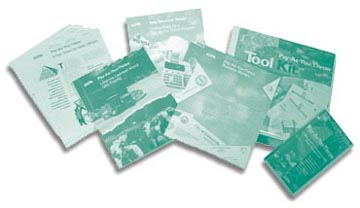PAYT Bulletin: Spring 1999
Other Issues
- Could PAYT Offer Hope For New York City's Recycling Program? (Winter 2003)
- PAYT Helps Cities Protect Climate (Summer 2002)
- Large Cities and PAYT (Winter 2002)
- Bigger, Older, Wiser: (Summer 2001)
- Maine Turns to PAYT (Spring 2001)
- State and City Profiles (Summer 2000)
- PAYT From Sea to Shining Sea (Winter 2000)
- PAYT Bulletin Archives
The PAYT Bulletin is designed to help solid waste planners and others get the latest pay-as-you-throw news and events. Use the links below to read articles from the Spring 1999 issue. To review other issues of the Bulletin, use the links on the right side of this page.
Rate Structure Design Booklet Now Available
Are you thinking about implementing a pay-as-you-throw (PAYT) program in your community, or fine-tuning the one already in place? Are you concerned about choosing the right price per can or bag of trash? Well, worry no more-help has arrived! The U.S. Environmental Protection Agency's (EPA's) newest PAYT tool, Rate Structure Design: Setting Rates for a Pay-As-You-Throw Program, was created to help you choose the right rate for your program to ensure environmental and economic sustainability while providing a more equitable solid waste management system. Through case studies, helpful tips, and step-by-step calculations, this booklet helps take the guesswork out of the potentially challenging process of setting rates for your PAYT program.
What Is Rate Structure Design?
Rate structure design (RSD) is the process by which you determine the price you charge per unit of municipal solid waste (MSW) set out by residents for collection. Through your PAYT rate structure, you introduce an economic incentive for residents to reduce waste and recycle more. An effective RSD aligns the power of this economic incentive with your community's specific MSW goals. It is essential, therefore, to clearly define those goals before implementing PAYT. The first section of the RSD booklet discusses the importance of goal setting and how it can help determine your pricing system, container type, and public education strategy. This section also outlines the general steps involved in RSD and discusses the three types of PAYT pricing systems in detail (i.e., proportional, variable, multi-tiered).
Drawing From Comparable CommunitiesThe second section of the booklet discusses one method for setting PAYT rates-drawing from comparable communities. Some communities start by examining programs in successful PAYT cities or towns, particularly those with similar demographic profiles. To get you started, a map of sample PAYT rate structures across the country is included in this section of the booklet.
Oconee County, Georgia
- Population: 25,000
- Start Date: 1994
- Rate structure: Proportional
- Price: $1.50 per 32-gallon bag
In some cases, examining similar communities is all that is necessary to arrive at an appropriate fee. Oconee County, Georgia, for example, simply looked at another community's program before deciding on a proportional system that set their fee at $1.50 per bag. According to John McNally, executive director of the Oconee County Clean and Beautiful Commission, since Oconee was the first county in the area to implement PAYT, they looked south to Tift County, Georgia, for examples of PAYT fees. "Tift County guided us a bit (on setting the price), but we also felt that $1.50 was probably the maximum people were going to pay to cooperate with this program," explained McNally.
The Six-Step ProcessUsing the rates of comparable communities might initially be the simplest approach to RSD. Eventually, though, you might need to revise your community's rates to more reliably cover costs, more effectively encourage waste reduction, or more vigorously achieve other community goals. Section III of the booklet explains how you can do this using a six-step RSD process and data from your community. The six steps are:
- Forecast residential MSW amounts.
- Determine the types of MSW services to be provided
- Estimate net costs of MSW.
- Determine PAYT revenues and MSW program cost coverage.
- Calculate PAYT rates.
- Adjust MSW services and PAYT rate structure.
To help clarify each step, the booklet provides step-by-step sample calculations using the hypothetical community of "Midtown," a mid-size (pop. 35,000) PAYT community. These examples walk you through Midtown's process of calculating MSW tonnages and net costs, choosing a container size, projecting program revenues, and ultimately calculating a rate structure. To illustrate the differences between the three pricing systems, the booklet details how Midtown calculated proportional, variable, and two-tier PAYT rates.
If you want your rate structure to account for all the direct and indirect costs of the MSW services you provide, the booklet offers advice on how to refine your PAYT rate structure accordingly. It discusses in more detail MSW costs, their allocation among MSW pathways and activities, and related issues you might want to consider when calculating PAYT rates.
What Have Some PAYT Communities Done With RSD?The final section of the booklet is a series of case studies that provide real-world examples and solutions to the issues discussed throughout the booklet. The highlighted com-munities range from small to large in size and have distinct rate structures to serve as models for a variety of community types. Below is some additional information on how Lansing, Michigan; Platteville, Wisconsin; Trinity County, California; and Wilmington, North Carolina, developed their rate structures.
Lansing, Michigan
- Population: 130,000
- Start Date:1976
- Rate structure: Proportional
- Price: $1.50 per 30-gallon bag
In Lansing, Michigan, the city added together all of its solid waste program costs and divided the total by the number of bags it expected to collect. This calculation resulted in a $1.50 per bag fee. According to Robert Moye, solid waste supervisor, the main goal of the rate structure is to cover the program's costs, since it operates from an enter-prise fund. Because the city competes with private haulers for residential customers, however, the rate also has to be as low as possible.
Platteville, Wisconsin
- Population:10,000
- Start Date:1990
- Rate structure:Multi-Tier
- Price:Local taxes for first-tier fee (includes one 35-gallon can/ week); $1.00 per 35-gallon bag for second tier fee
Platteville, Wisconsin, residents are charged $1 for each extra bag of trash they set out beyond a 35-gallon limit. The $1 per bag fee reflects the cost of collecting, hauling, and tipping 'excess' MSW, as well as the cost of the bags, the incentive for stores to carry the bags ($.10 each), administrative tasks, and the yard waste collection and composting operation. Residents are provided with weekly collection of one 35-gallon clear bag or garbage can weighing up to 50 pounds. Both this service and curbside recycling collection are paid for out of city taxes.
Howard Crofoot, director of public works for Platteville, explained that the first thing to consider when establishing a rate structure is the actual cost of service. He cautioned that it also is important to get input from the public, because if the price is too high, problems with illegal dumping might occur. Based on these factors, the city determined the best rate to be $1 per bag. Under PAYT, the city's recycling rate is approximately 35 percent, or about 10 percentage points higher than the state's 25 percent goal.
In Trinity County, California, residents pay $5 per cubic yard, or $1 a bag (the sixth bag is free, since the county estimates that there are six bags in a cubic yard), for solid waste disposal. The PAYT system was implemented because a $100 annual benefit assessment collected from households was not enough to run the county's landfill and eight collection centers. Although it might have been easier to raise the assessment, the county's supervisors were against it. Instead, they estimated their additional costs at about $5 a cubic yard and opted for the unit-based system. The fee was set as low as possible, since the county was concerned about illegal dumping. The county also felt a per-bag fee would be more fair to the residents, and they hoped it would encourage recycling.
Wilmington, North Carolina
- Population: 62,000
- Start Date: 1992
- Rate structure: Variable Rate
- Price:
$12.75 per month for 40-gallon cart;
$15.75 per month for 90-gallon cart
One approach to rate structure design is to conduct an in-depth analysis of costs to calculate an appropriate unit price. In Wilmington, North Carolina, for example, the city used a form of full cost accounting to identify all of its costs before establishing its pricing system. According to Bill Reed, superintendent of operations, it is important that the city's fees cover the costs of the program, since it operates from an enterprise fund. Reed explained, "Setting your fees depends on how exact you want or need to be."
The city's main goal was to establish an equitable system, one that rewarded residents who generate less trash. Consequently, the city offers a range of options in its variable rate pricing system, from weekly collection of a 40-gallon cart ($12.75 per month), to weekly collection of a 90-gallon cart ($15.75 per month), to weekly collection of two 90-gallon carts ($22.35), to twice weekly collection of one 90-gallon cart ($31.30). Stickers for overflow trash can be purchased for $1 per 33-gallon bag. By making trash rates more equitable, the city received a secondary benefit of increased recycling.
As you can see, Rate Structure Design: Setting Rates for a Pay-As-You-Throw Program puts a wealth of information right at your fingertips. Order your copy today and let it help you develop a PAYT rate structure that meets your community's unique goals. To obtain a free copy of the booklet, please call the PAYT Helpline at 888 EPA-PAYT or order online.
Stay Informed on PAYT
Is your collection of PAYT resources up-to-date? Rate Structure Design: Setting Rates for a Pay-As-You-Throw Program should be the newest addition to your PAYT library, but do you have a copy of the PAYT video released this past fall and the comprehensive PAYT tool kit? What about the Pay-As-You-Throw Success Stories or the how-to guidebook, Pay-As-You-Throw: Lessons Learned About Unit Pricing? Every one of these items is available to you at no cost simply by calling the PAYT Helpline at 888 EPA-PAYT or visiting the PAYT Web site.

![[logo] US EPA](../gif/logo_epaseal.gif)